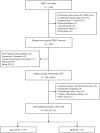Usefulness of the delta neutrophil index to predict 30-day mortality in patients with ST segment elevation myocardial infarction
- PMID: 29146994
- PMCID: PMC5691079
- DOI: 10.1038/s41598-017-15878-5
Usefulness of the delta neutrophil index to predict 30-day mortality in patients with ST segment elevation myocardial infarction
Abstract
This study aimed to evaluate the association between the delta neutrophil index (DNI), which reflects immature granulocytes, and the severity of ST-elevation myocardial infarction (STEMI), as well as to determine the significance of the DNI as a prognostic marker for early mortality and other clinical outcomes in patients with STEMI who underwent reperfusion. This retrospective, observational cohort study was conducted using patients prospectively integrated in a critical pathway program for STEMI. We included 842 patients diagnosed with STEMI who underwent primary percutaneous coronary intervention (pPCI). Higher DNI values at time-I (within 2 h of pPCI; hazard ratio [HR], 1.075; 95% confidence interval [CI]: 1.046-1.108; p < 0.001) and time-24 (24 h after admission; HR, 1.066; 95% CI: 1.045-1.086; p < 0.001) were significant independent risk factors for 30-day mortality. Specifically, DNI values >2.5% at time-I (HR, 13.643; 95% CI: 8.13-22.897; p < 0.001) and > 2.9% at time-24 (HR, 12.752; 95% CI: 7.308-22.252; p < 0.001) associated with increased risks of 30-day mortality. In conclusion, an increased DNI value, which reflects the proportion of circulating immature granulocytes in the blood, was found to be an independent predictor of 30-day mortality and poor clinical outcomes in patients with acute STEMI post-pPCI.
Conflict of interest statement
The authors declare that they have no competing interests.
Figures



References
MeSH terms
LinkOut - more resources
Full Text Sources
Other Literature Sources

